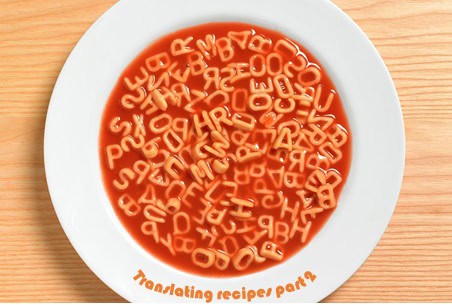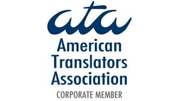
Recently I have done several projects which involved translating recipes. On the face of it this seems like a simple task: take the list of ingredients and convert into the target language; then simply do the same for the recipe method. Recipes tend to be very well structured, written in a series of simple to follow logical steps and specifically designed to avoid any possible linguistic misinterpretation which might result in a culinary mishap. I even naively thought that the repetitive nature of recipes might make this a dull process. In fact, the task was neither as simple as I’d imagined nor was it at all monotonous. Food is so culturally specific; the translation process was full of wonderful culinary and linguistic discoveries!
Ingredients
It comes as little surprise that availability of the basic raw materials is challenge number one in translating recipes. While “quark” may be ubiquitous in German supermarkets, it’s much harder to track down in the UK and just try locating “halloumi” in a French supermarket. Then there’s the question of how finickity to get over little details. Purists may debate whether “Strudelteig” (strudel pastry) is different to “filo” pastry (the former is slightly thicker, apparently), but for many standard recipe books either can be substituted depending on availability. Ultimately the food editor will have to advise and make a decision.
Then there are the items which seem straightforward but which open up all sorts of questions. German recipes might specify “Sahne” – easy, “cream” in English. But which kind of cream do they mean? English recipes would let you know whether single, double or whipping cream is required. And the German cream varieties found in most supermarkets don’t map straightforwardly onto UK categories in terms of their fat content. Similarly several of the German recipes I worked on were content to refer to “Zucker” (“sugar”) with no hint as to whether this might be caster, granulated, icing or any of the myriad brown, muscovado, demerara varieties on offer.
Flour is another minefield in translating recipes, where country-specific knowledge is invaluable. The Italian “farro” is often translated simply as “spelt”, but this conceals all sorts of other possibilities. For a start, there is “farro piccolo”, “medio” or “grande”. The latter is indeed spelt, while the first two would usually be translated as “Einkorn” and “Emmer”. Several European countries use flour numbering systems for clarity, although with different countries using different numbering systems and with the UK preferring textual flour descriptors the translator is often left having to undertake careful research before deciding on their translation. And once you’ve decided on a precise definition, you hit the question of availability again – the Italians and Germans are passionate about their flour and a wide choice would be available even in smaller shops. Here in the UK you are dependent on a really large supermarket, specialist flour producer or health food store for equivalent options. I have found reference to at least eight types of German rye flour, and one cookbook I tackled used three types: 1150 (medium rye), 997 (sifted light rye) and 815 (an almost white rye which is even more highly refined than 997). Here the translator’s task is to provide sufficient information to enable the food editor to determine the best local choice in each case, balancing availability of ingredients against a desire for authenticity.
After looking at the challenges of converting the ingredients used in a foreign recipe into your target language, I’ll now be discussing some of the other issues that arise when translating recipes, especially when it comes to availability and different cooking traditions.
Ready made products
A tricky challenge in the translator’s ingredients obstacle course are products which are available in ready-made form in some countries, but which will require detailed instructions on how to make them from scratch in other locations.
The domestic German baker can readily acquire “Tortenguss” (a glaze) to conjure up one of those beautiful, gleaming fruit-topped tarts or cakes you see in the Konditorei window as you take your Sunday afternoon stroll. The English home cook attempting to replicate this will have to be more resourceful and will need to make this product from scratch, perhaps using gelatine or arrowroot as the gelling agent.
Similarly, it is by no means frowned on in Germany to resort to shop-bought lebkuchen spices when rustling up your Christmas cookies. The English cook will need a well-stocked spice cupboard and some guidance on the relative proportions of cinnamon, cloves, allspice, nutmeg, coriander, cardamom, ginger, mace and star anise to use.
Once again we step outside the translator’s immediate remit but the food editor may need assistance when it comes to giving instructions on how to create a good homemade option in these cases.
What makes an ingredient exotic?
Occasionally you will find ingredients which require detailed description in the source language because they are considered exotic or unusual, when they are absolutely commonplace in your target country. For instance, one German recipe I tackled went into great detail explaining what garam masala was and how you could go about obtaining this “obscure” ingredient.
That whole section of text was translated but then flagged up as redundant for the book editor to delete as superfluous for the average UK home cook. This in turn had repercussions for the graphic designers as the page layout had been built around an information box containing this information.
Health and Safety when translating recipes
Not only do cooking traditions vary between countries, health and safety advice can be very different too. I worked on a series of German recipes, which specifically instruct the reader to wash the chicken before cooking, a practice which the UK Food Standards Agency explicitly warns against due to the risk of spreading campylobacter.
Recipe books also often offer advice for pregnant women when it comes to eating things like raw egg, mould-ripened cheeses and so on. The guidelines in this area are well known to be very country-specific with French expectant mothers quaffing wine and consuming camembert to their heart’s content, where their US counterparts are warned off such delights.While the translator may not be expected to be au fait with all such regional discrepancies, it certainly helps the editor if these can be flagged up early on in the translation process and the text amended accordingly.
While the translator may not be expected to be au fait with all such regional discrepancies, it certainly helps the editor if these can be flagged up early on in the translation process and the text amended accordingly.
In the last part of this blog on translating recipes, I tackle the vexed issue of quantities and measurements and then the more delightful experience of culinary exploration.
Quantities
Even countries which share a common language offer a baffling array of kitchen measuring methods. Younger British cooks who are versed in the metric system are also used to having to deal with granny’s hand-me-down family recipes in imperial measures. As a consequence, many of our cookbooks offer metric-imperial conversion tables as standard.But even the flexible Brits throw their hands up in dismay at the Americans and their cup measurements. How imprecise! And then there’s the fact that a US cup is not exactly the same as an Australian cup. Then again, when you use these kinds of measure, maybe you have to develop a true feel for what is right in a recipe, how many professional chefs truly weigh out their ingredients I wonder.
But even the flexible Brits throw their hands up in dismay at the Americans and their cup measurements. How imprecise! And then there’s the fact that a US cup is not exactly the same as an Australian cup. Then again, when you use these kinds of measure, maybe you have to develop a true feel for what is right in a recipe, how many professional chefs truly weigh out their ingredients I wonder.
When translating, you discover all sorts of measures which are similarly vague. It seems clear that German “Prise” can be translated as English “pinch”, but then how to tackle “Msp: Messerspitze” (literally a “knife tip”). It’s easy to visualise a dry ingredient on the tip of the knife, and it sounds similar to a “pinch” in quantity.But could it be a bit less, or a bit
But could it be a bit less, or a bit more. And what about if a single recipe refers to both “Prise” and “Msp”, is there really any difference!? Perhaps only the original recipe writer will know.
Both German and French baking recipes seem to have a fondness for using small sachets of crucial ingredients such as baking powder, vanilla sugar etc.So, where a German cake might require 1 sachet of baking powder, the converted English recipe needs a reference in tsp. Muddying the waters still further, German brand Dr. Oetker sell 16g sachets of baking powder in Germany but in the UK Tesco offer a 5g sachet by the very same brand.
So, where a German cake might require 1 sachet of baking powder, the converted English recipe needs a reference in tsp. Muddying the waters still further, German brand Dr. Oetker sell 16g sachets of baking powder in Germany but in the UK Tesco offer a 5g sachet by the very same brand.
Personal culinary and linguistic discoveries in translating recipes
It’s been a while since I lived in Germany and explored the full delights of the “Kaffee und Kuchen” (coffee and cake) culture, so these days I am excited when my work projects introduce me to new baked treats. The Dresdner Zuckerkuchen might be simple, but often the best things are – just a plain yeasted cake which is sprinkled with sugar. As the name suggests, a speciality of the town of Dresden.
With apologies to all the “Mett” fans out there, I for one had never come across this German delicacy until I was required to translate a recipe for it (apparently it’s a thing in Belgium and the Netherlands too). There’s no gilding the lily here – it is basically a plate of raw pork mince with a bit of salt and pepper thrown in, and possibly some onion or garlic if you’re feeling fancy.
A friend who used to work in the food industry refused to believe that raw pork could be served in this way (we’re back with cross-cultural health and safety concerns here), but it has its own wiki page to prove its existence. In fact the wiki page is worth checking out for the “Mettigel” (Mett hedgehog) complete with raw onion spines and olive eyes, which is a buffet bar staple. So, my culinary translation adventures brought me some new recipes to try, and some recipes which I’m yet to be persuaded by, and these have been fun projects to work on.
So, my culinary translation adventures brought me some new recipes to try, and some recipes which I’m yet to be persuaded by, and these have been fun projects to work on.
About the Author
Alison Tunley
Alison is a seasoned freelance translator with over 15 years of experience, specialising in translating from German to English. Originally from Wales, she has been a Londoner for some time, and she holds a PhD in Phonetics and an MPhil in Linguistics from the University of Cambridge, where she also completed her First Class BA degree in German and Spanish… Read Full Bio
Reference









